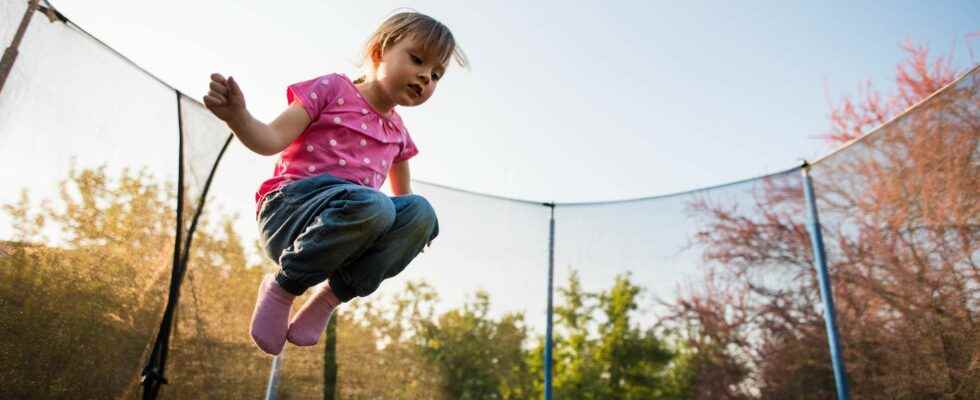Playground for some, sport for others, the trampoline is an activity that offers great sensations. Round or rectangular, this sports equipment can be installed in all gardens. Inground, semi-inground or surface trampoline, our advice for choosing a trampoline adapted to your needs.
You will also be interested
Who has never made a few more or less successful jumps on a trampoline? This sports equipment which allows let off steam integrated, thanks to the health crisis, many gardens. Manufacturers offering a wide range of trampolines (round, rectangular, oval, octagonal) dedicated to family or sports use. Very widely used, the surface trampoline has many advantages but is now in competition with buried or semi-buried trampolines.
Buried or semi-buried trampoline: work to be planned
Unlike surface trampoline models, in-ground trampolines are above all more discreet than their counterparts, since they are installed at ground level. However, while in-ground trampolines facilitate access to the jumping mat, these models are known to be more stable and resistant. Disadvantage, they require major work which is not without impacting the garden. Indeed, to allow rebounds and deformation of the jumping mat, it is mandatory to dig a pit of the same surface as the latter. Depending on the manufacturers and the size of the trampoline, the depth of this hole varies from 60 to 90 centimeters. If on draining soil, this operation remains physical but feasible, on soils limestone or clay is another pair of sleeves… In addition, on this type of ground, it is necessary to provide for the installation of a drain, or even a pump to evacuate rainwater. On soft ground, semi-buried laying is preferred.
Rules to follow when setting up a trampoline
Whether it is an inground trampoline or not, a trampoline consists of a jumping mat connected around its perimeter by springs or by a mesh of elastics to a structure in aluminum or in galvanized steel protected by protective cushions. Regardless of the type of trampoline, the tubular structure must be installed:
- on perfectly horizontal ground, avoiding hard ground (terrace, slab, etc.);
- away from other equipment (pool, barbecue, etc.). Provide a clearance zone of two meters all around the trampoline;
- away from any obstacles. Allow clearance above the trampoline of between three meters (buried trampoline) and eight meters (surface trampoline).
Finally, it is recommended to regularly check the correct tightening of the screws and the condition of the structure and to anchor the structure to the ground using the sardines delivered with the trampoline.
Dig a pit to install a buried or semi-buried trampoline
Buried or not, the digging of the pit is a similar operation, only the diameter of the future pit differs. In the first case, it incorporates a rim of about 20 centimeters on which the feet of the structure will rest. In the second case, the feet will be directly on the ground.
- determine the location of the trampoline;
- trace the outline of the pit on the ground;
- make sure that the center of the jumping mat is perfectly aligned with the center of the pit;
- dig from the center to the depth recommended by the manufacturer;
- widen the hole by going up towards the edge of the pit, giving it the shape of a bowl;
- position the trampoline and give it a try, and dig a little deeper if necessary;
- anchor the trampoline to the ground.
Choosing the shape and dimensions of a trampoline
Faced with the multitude of trampolines available, the choice is not the easiest to find the right model. If the size (from 2 meters up to 4.30 meters depending on the manufacturer) depends on the allocated budget, this criterion must also take into account the space available in the garden. Another criterion to take into account is the maximum authorized weight. In terms of shape, buried or semi-buried trampolines are available round, rectangular or oval.
- Round buried trampoline: when jumping, the user is brought back to the center of the jumping mat. Advantage the risk ofaccident is limited.
- Rectangular buried trampoline: allowing sequences to be created, this type of trampoline is popular with sportsmen.
Standards, use: safety first!
For user safety, ensure that your future trampoline complies with the standards in force.
- Standard NF EN 13219, concerning the manufacture of trampolines.
- Standard NF EN 913 relating to the tests and use of trampolines.
- Standard NF EN 71-14 on the safety of toys.
Also be sure to follow the safety instructions to avoid accidents:
- do not jump more than one simultaneously;
- take off your shoes and empty your pockets before accessing the jumping mat;
- do not use the trampoline in rainy weather or wind.
What you must remember
- A trampoline should always be used under adult supervision.
- If the accidents are less violent with an inground trampoline, it is strongly advised to equip it with a safety net.
- Do not modify the structure of a surface trampoline to transform it into an in-ground trampoline.
Interested in what you just read?
